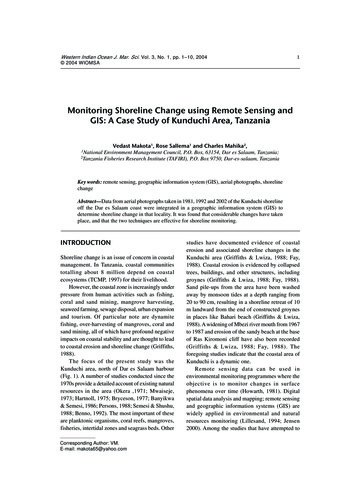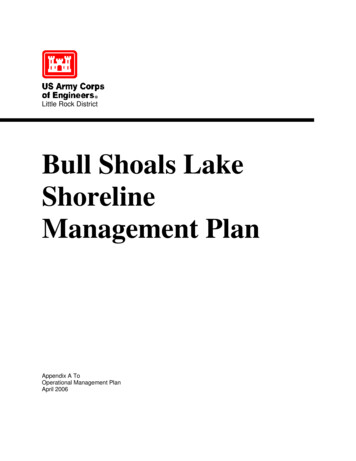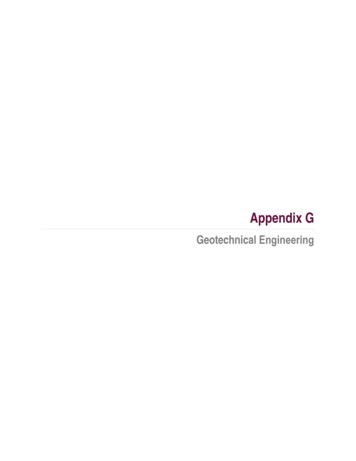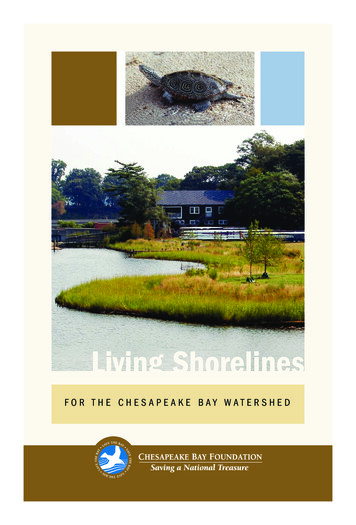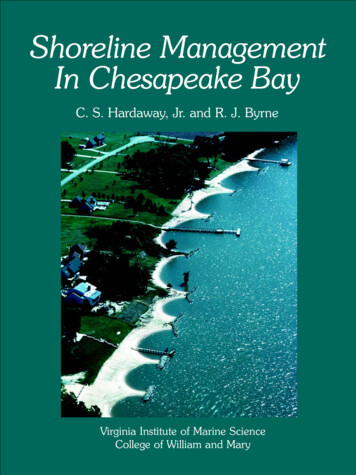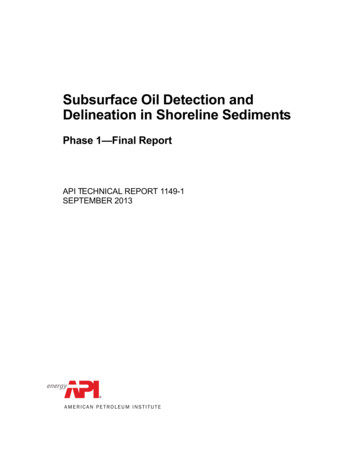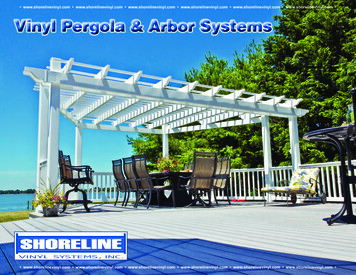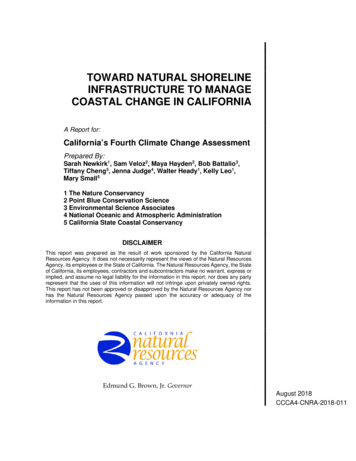
Transcription
TOWARD NATURAL SHORELINEINFRASTRUCTURE TO MANAGECOASTAL CHANGE IN CALIFORNIAA Report for:California’s Fourth Climate Change AssessmentPrepared By:Sarah Newkirk1, Sam Veloz2, Maya Hayden2, Bob Battalio3,Tiffany Cheng3, Jenna Judge4, Walter Heady1, Kelly Leo1,Mary Small51 The Nature Conservancy2 Point Blue Conservation Science3 Environmental Science Associates4 National Oceanic and Atmospheric Administration5 California State Coastal ConservancyDISCLAIMERThis report was prepared as the result of work sponsored by the California NaturalResources Agency. It does not necessarily represent the views of the Natural ResourcesAgency, its employees or the State of California. The Natural Resources Agency, the Stateof California, its employees, contractors and subcontractors make no warrant, express orimplied, and assume no legal liability for the information in this report; nor does any partyrepresent that the uses of this information will not infringe upon privately owned rights.This report has not been approved or disapproved by the Natural Resources Agency norhas the Natural Resources Agency passed upon the accuracy or adequacy of theinformation in this report.Edmund G. Brown, Jr. GovernorAugust 2018CCCA4-CNRA-2018-011
ACKNOWLEDGEMENTSThis project was supported by many advisors, who were very generous with their time andexpertise. Specifically: Andrea Pickart, Humboldt Bay National Wildlife Refuge; Brenda Goeden,San Francisco Bay Conservation and Development Commission; Michelle Orr, Environmental ScienceAssociates; Damien Kunz, Environmental Science Associates; Eric Joliffe, United States Army Corps ofEngineers; Christina McWhorter, Hamilton Wetlands Plant Nursery; Jeff Melby, California StateCoastal Conservancy; Louis White, Environmental Science Associates; Paul Jenkin, SurfriderFoundation; Evyan Sloane, California State Coastal Conservancy; Rick Nye, Seal Beach NationalWildlife Refuge; Marilyn Latta, California State Coastal Conservancy; Kathy Boyer, San FranciscoState University; Su Corbaly, California State Coastal Conservancy; Elizabeth Gagneron, CaliforniaState Coastal Conservancy; Mary Matella, California Coastal Commission; Jennifer Mattox, StateLands Commission; Laura Engeman, San Diego Climate Collaborative; Dani Boudreau, Tijuana RiverNational Estuarine Research Reserve; Joel Gerwein, California State Coastal Conservancy; DavidBehar, San Francisco Public Utility Commission; Jack Liebster, Marin County Planning; LeslieEwing, California Coastal Commission; Juliette Hart, United States Geological Survey; Amber Parais,San Diego Climate Collaborative; Sara Hutto, Greater Farallones National Marine Sanctuary; NatalieCosentino-Manning, National Oceanic and Atmospheric Administration National Marine FisheriesService; Jeremy Lowe, San Francisco Estuary Institute; Kif Scheuer, Local Government Commission;George Domurat, U.S. Army Engineer Institute for Water Resources; Ken Schreiber, Land UsePlanning Services, Inc.; Bruce Bekkar, City of Del Mar; Joseph Tyburczy, California Sea GrantExtension; Brian Brennan, Beach Erosion Authority for Clean Oceans and Nourishment; Luisa Valiela,Environmental Protection Agency; Christina Toms, San Francisco Bay Regional Water Quality ControlBoard; John Rozum, National Oceanic and Atmospheric Administration Office for CoastalManagement; Becky Lunde, National Oceanic and Atmospheric Administration Office for CoastalManagement; Deborah Ruddock, California State Coastal Conservancy; Chris Williamson, City ofOxnard; Edward Curtis, San Francisco State University; Sergio Vargas, Ventura County; DeanKubani, City of Santa Monica; Jenny Dugan, University of California Santa Barbara; Maren Farnum,State Lands Commission; Patrick Mulcahy, State Lands Commission; Madeline Kinsey, CaliforniaState Parks; Andrew Gunther, Center for Ecosystem Management and Restoration; Kristen Goodrich,Tijuana River National Estuarine Research Reserve; Monique Myers, California Sea Grant Extension;Warner Chabot, San Francisco Estuary Institute; Alex Westhoff, Marin County.ii
PREFACECalifornia’s Climate Change Assessments provide a scientific foundation for understandingclimate-related vulnerability at the local scale and informing resilience actions. TheseAssessments contribute to the advancement of science-based policies, plans, and programs topromote effective climate leadership in California. In 2006, California released its First ClimateChange Assessment, which shed light on the impacts of climate change on specific sectors inCalifornia and was instrumental in supporting the passage of the landmark legislationAssembly Bill 32 (Núñez, Chapter 488, Statutes of 2006), California’s Global Warming SolutionsAct. The Second Assessment concluded that adaptation is a crucial complement to reducinggreenhouse gas emissions (2009), given that some changes to the climate are ongoing andinevitable, motivating and informing California’s first Climate Adaptation Strategy released thesame year. In 2012, California’s Third Climate Change Assessment made substantial progress inprojecting local impacts of climate change, investigating consequences to human and naturalsystems, and exploring barriers to adaptation.Under the leadership of Governor Edmund G. Brown, Jr., a trio of state agencies jointlymanaged and supported California’s Fourth Climate Change Assessment: California’s NaturalResources Agency (CNRA), the Governor’s Office of Planning and Research (OPR), and theCalifornia Energy Commission (Energy Commission). The Climate Action Team ResearchWorking Group, through which more than 20 state agencies coordinate climate-relatedresearch, served as the steering committee, providing input for a multisector call for proposals,participating in selection of research teams, and offering technical guidance throughout theprocess.California’s Fourth Climate Change Assessment (Fourth Assessment) advances actionablescience that serves the growing needs of state and local-level decision-makers from a variety ofsectors. It includes research to develop rigorous, comprehensive climate change scenarios at ascale suitable for illuminating regional vulnerabilities and localized adaptation strategies inCalifornia; datasets and tools that improve integration of observed and projected knowledgeabout climate change into decision-making; and recommendations and information to directlyinform vulnerability assessments and adaptation strategies for California’s energy sector, waterresources and management, oceans and coasts, forests, wildfires, agriculture, biodiversity andhabitat, and public health.The Fourth Assessment includes 44 technical reports to advance the scientific foundation forunderstanding climate-related risks and resilience options, nine regional reports plus an oceansand coast report to outline climate risks and adaptation options, reports on tribal andindigenous issues as well as climate justice, and a comprehensive statewide summary report.All research contributing to the Fourth Assessment was peer-reviewed to ensure scientific rigorand relevance to practitioners and stakeholders.For the full suite of Fourth Assessment research products, pleasevisit www.climateassessment.ca.gov. This report is intended to facilitate the use of NaturalShoreline Infrastructure along California’s coast, improving the resilience of communities andhabitats in the face of climate change.iii
ABSTRACTFlooding and erosion caused by rising sea levels and powerful storms threaten propertythroughout coastal California. To protect against these climate-change related threats,landowners will certainly take action, and the default industry standard response has been totry to “hold the line” against the encroaching sea by constructing seawalls, dikes, levees andother forms of coastal armoring. While armoring may in some cases provide acceptable shortterm protection, armoring also tends to accelerate shoreline erosion, exacerbating hazards topeople and leading to the eventual loss of critical wildlife habitat and public beaches.Natural Shoreline Infrastructure can be as effective as armoring, while having the addedbenefits of preserving coastal habitat and public access. Recognizing this, California agencieshave mandated that decision-makers prioritize its use in planning and investment decisions.Yet, planners have encountered many stumbling blocks as they have tried to incorporate theseapproaches into coastal resilience plans. Major obstacles include: a lack of a common definitionand shared terminology; lack of expertise; lack of precedent; and the absence of siting guidanceand technical design standards.Here, we set out to enable planners to adopt Natural Shoreline Infrastructure by filling in themissing information. With the input of dozens of coastal managers who served on our TechnicalAdvisory Committee, we developed a definition and collected a list of case studies whereNatural Shoreline Infrastructure has already been successfully deployed in California. Drawingfrom these and other projects, we collected into one place the first detailed technical guidancefor implementation, including siting criteria and design thresholds. These criteria informdecisions about where and when to use six types of Natural Shoreline Infrastructure (e.g. sanddunes, seagrass beds). Using Monterey Bay and Ventura County projects as examples, wedemonstrate how to use the technical guidance in tandem with spatial data to match aparticular shoreline environment with appropriate Natural Shoreline Infrastructure options,creating “blueprints” for action.The information in this report is intended to facilitate the use of Natural ShorelineInfrastructure along California’s coast, improving the resilience of communities and habitats inthe face of climate change.Keywords: Natural Shoreline Infrastructure, living shorelines, green infrastructure, coastalprotection, coastal resilience, sea level rise, coastal storms, flooding, erosion, coastal armoring,seawalls, hazard mitigation, case studies, vegetated dunes, wetlands, cobble berms, marsh sills,tidal benches, horizontal levee, oyster reefs, eelgrass beds, outer coast, estuaries, coastalecosystemsPlease use the following citation for this paper:Newkirk, Sarah, Sam Veloz, Maya Hayden, Walter Heady, Kelly Leo, Jenna Judge, RobertBattalio, Tiffany Cheng, Tara Ursell, Mary Small. (The Nature Conservancy and PointBlue Conservation Science). 2018. Toward Natural Infrastructure to Manage Shorelineiv
Change in California. California’s Fourth Climate Change Assessment, CaliforniaNatural Resources Agency. Publication number: CCCA4-CNRA-2018-011.v
HIGHLIGHTS Coastal planners have faced many stumbling blocks when attempting to incorporateNatural Shoreline Infrastructure strategies into climate-change adaptation plans, andhave instead often implemented short-term solutions like coastal armoring, and willcontinue to do so until significant hurdles to implementing other strategies can beovercome. Two major hurdles for planners are a lack of precedent and a dearth of technicalguidance applicable to California’s varied environmental settings. To begin to addressthe first, we’ve collected five detailed case studies where planners have alreadysuccessfully implemented different types of Natural Shoreline Infrastructure. To address the second hurdle to implementation we provide detailed technical guidanceinformation to direct planners in evaluating and deciding where, when, and how to usesix types of Natural Shoreline Infrastructure (e.g. sand dunes, seagrass beds), for optimalresults. Using Monterey Bay and Ventura County as examples, we demonstrate how to use thisguidance in tandem with local spatial data to match a particular shoreline environmentwith appropriate Natural Shoreline Infrastructure options, creating “blueprints” foraction. Going forward, state agencies and NGOs should support demonstration projects thatinclude testing and monitoring, so that the community of practitioners may continue toimprove upon Natural Shoreline Infrastructure approaches and so they can be appliedon larger scales, to enhance resilience to climate-change related hazards and maintainpublic access to healthy shorelines long into the future.WEB nia/vi
TABLE OF CONTENTSACKNOWLEDGEMENTS . iiPREFACE . iiiABSTRACT . ivHIGHLIGHTS . viTABLE OF CONTENTS. vii1: Introduction . 11.1 Purpose of This Study . 11.2 Overview . 11.3 Shoreline Protection Approaches . 21.4 Natural Infrastructure Defined and Codified into State Law . 41.5 Creating a Shared Definition of Natural Shoreline Infrastructure Among Stakeholders. 42: Case Studies . 52.1 Seal Beach National Wildlife Refuge Thin-layer Salt Marsh Sediment Augmentation PilotProject . 62.2 Surfers’ Point Managed Shoreline Retreat Project . 72.3 San Francisco Bay Living Shorelines: Nearshore Linkages Project . 82.4 Hamilton Wetland Restoration Project . 82.5 Humboldt Coastal Dune Vulnerability and Adaptation Climate Ready Project. 92.6 Lessons Learned . 93: Technical Guidance on Natural Shoreline Infrastructure. 103.1 Introduction and Appropriate Use . 103.2 Vegetated Dunes . 113.2.1 Setting . 123.2.2 Design Guidance . 123.2.3 Dune Subtype and Vegetation . 143.2.4 Construction and Monitoring. 163.3 Cobble Berms . 163.3.1 Setting . 173.3.2 Design Guidance . 18vii
3.3.3 Construction and Monitoring. 193.4 Marsh Sills . 193.4.1 Setting . 203.4.2 Design Guidance . 203.4.3 Construction and Monitoring. 213.5 Tidal Benches . 223.5.1 Setting . 233.5.2 Design Guidance . 233.5.3 Construction and Monitoring. 253.6 Native Oyster Reef . 253.6.1 Setting . 263.6.2 Design Guidance . 273.6.3 Construction and Monitoring. 283.7 Eelgrass Beds . 293.7.1 Setting . 303.7.2 Design Guidance & Implementation . 303.8 Other Considerations for Natural Shoreline Infrastructure. 324: Development of Blueprints for Deploying Natural Shoreline Infrastructure . 334.1 Overview . 334.2 Methods . 334.3 Preliminary Results . 364.3.1 Suitability of Vegetated Dunes in Monterey Bay and Ventura County . 364.3.2 Suitability of Cobble Berms in Monterey Bay and Ventura County. 364.4 Discussion and Anticipated Products . 385: Conclusions and Future Directions . 386: References. 40APPENDIX A: Technical Advisory Committee Membership .A-1APPENDIX B: Literature Defining Natural Shoreline Infrastructure . B-1APPENDIX C: Common Native Plants for Restoration in California Coastal Habitats . C-1viii
APPENDIX D: Detailed Methods of Blueprints for Deploying Natural ShorelineInfrastructure . D-1D.1 Spatial Data Inputs .D-4D.2 Application of Thresholds to Outer Coast Measures.D-4D.1.1 Sand Dunes .D-4D.1.2 Cobble Berms .D-4D.1.3 Opportunities to Improve Location Suitability Through Managed Retreat .D-5D.2 Application of Thresholds to Estuary Measures .D-6D.2.1 Marsh Sill .D-6D.2.2 Tidal Bench .D-7D.2.3 Oyster Reefs and Eel Grass Beds .D-7ix
1: Introduction1.1 Purpose of This StudyThis report aims to provide crucial information and guidance, so that in response to the threatof shoreline flooding and erosion—exacerbated by climate change—California planners cancurtail their reliance on coastal armoring and can instead begin to more widely deploy NaturalShoreline Infrastructure solutions.Currently, planners interested in using Natural Shoreline Infrastructure approaches face a hostof obstacles (Caldwell et al. 2015). In consultation with our Technical Advisory Committee(Section 1.5, Appendix A), we identified four major obstacles that we could feasibly tackle andbegin to overcome: (1) a lack of clarity over what Natural Shoreline Infrastructure entails; (2) aperceived lack of precedent for Natural Shoreline Infrastructure in California; (3) a lack oftechnical guidance for siting and design to help planners pinpoint which methods to use andwhere; (4) and a lack of examples demonstrating the application of siting guidelines to evaluatesuitability of Natural Shoreline Infrastructure in specific locales.Here, we address each of these challenges. First, we develop a shared definition of NaturalShoreline Infrastructure with stakeholders (Sections 1.4, 1.5). We then present five case studieswhere Natural Shoreline Infrastructure has been used successfully in California (Section 2,Appendix E). We also provide detailed technical guidance for deciding where, when and howto use Natural Shoreline Infrastructure approaches, according to local conditions (Section 3).Last, we demonstrate how the technical guidance can be applied using spatial data to evaluatesuitability of these approaches in Monterey Bay and Ventura County (Section 4, Appendix F).1.2 OverviewCalifornia’s iconic coast links together thousands of miles of coastal habitats which arefoundational to the high biodiversity unique to the coast and provide benefits to millions ofpeople (Heady et al. 2018). Cliffs, dunes, wetlands, estuaries, and beaches provide criticalhabitat to fish, endangered plants, marine mammals, and birds travelling along the PacificFlyway. (Neuman et al. 2008; Hughes et al. 2014; Heady et al. 2018).It is impossible to overstate the importance and irreplaceability of these habitats, which serve asessential nursery, feeding and resting areas for both terrestrial and marine species. California’scoastlines are also critical habitat for people. Millions flock to the coast annually, to fish, swim,surf, rest, honor sacred traditions and to be surrounded by nature (NOAA 2015, Heberger et al.2009). Beach-goers in California spend approximately 3 billion annually, and the non-marketbenefits of coasts, when translated into dollar figures, are greater than 2 billion per year(Kildow and Colgan 2005).Unfortunately, more than 90% of coastal wetlands, beaches, and estuarine intertidal lands havealready been converted to agriculture or development (Dahl 1990, Zedler 1996). The remaining10 % will likely continue to shrink from climate change-induced hazards. Coastal bluffs arealready eroding at a rate of 0.30 m (1 ft) per year in many places, and that rate of change willlikely increase over the coming decades as sea levels rise and Pacific storms intensify (Hapkeand Reid 2007, Vitousek et al. 2017). By the turn of the century, projections of 1 to 2 m (3 to 6 ft)1
of sea level rise could eliminate up to two-thirds of Southern California beaches, unlessmeasures are taken to curb this loss (Vitousek et al. 2017). Similarly, Heady et al. (2018) foundthat 55% of all coastal habitat area throughout California is highly vulnerable to five feet of sealevel rise. These same forces also threaten to flood nearly 100 billion worth of property alongthe length of the California coast (Heberger et al. 2009).1.3 Shoreline Protection ApproachesThe magnitude of the looming ecological, social, and economic impacts described aboveguarantees that coastal landowners will act to protect their assets. There are two primarystrategies to protect the shoreline and the communities that live along the coast: coastalarmoring and natural infrastructure. Natural infrastructure, which for the purposes of thisreport we are calling “Natural Shoreline Infrastructure,” (see Section 1.5 for a more detailedaccount of the definition) offers many advantages over armoring, but it’s an approach that hasbeen under-appreciated and under-utilized.Coastal armoring typically entails the construction of seawalls, revetments, dikes and levees to“hold the line” and keep encroaching water and winds at bay. Coastal armoring has been theindustry standard response to erosion for centuries, but it is an approach that has proven to bedetrimental to its intended purpose in the long term, and it comes with many short-termconsequences as well (Dugan 2008). Paradoxically, by attempting to control the dynamic natureof shorelines, coastal armoring tends to actually increase the risk of destruction of the veryproperties it was built to protect. Sea walls and other hard structures can accelerate thedisappearance of beach in front of the wall and on neighboring properties by reflecting waveenergy and interfering with natural sediment dynamics (USACE 1981). Sea walls also blockbeaches from naturally migrating landward (Figure 1; Melius and Caldwell 2015).Armoring structures have other social consequences, such as limiting beach access, andinhibiting recreation and other human uses (USACE 1981, Dugan 2008, Griggs 2005). They canbe expensive to install and require costly ongoing maintenance. Additionally, sea level rise willlimit the practical life span of these structures. (A thorough exploration of economic costs andbenefits is outside the scope of this paper, but for case study examples looking at relative costsand benefits of armoring see ENVIRON 2015 and Leo et al. 2017 Appendix F.) Thus, costlyarmoring investments ultimately undermine safety, ecological function, public access and longterm coastal resiliency.2
Figure 1: Diagram showing how armoring prevents beach migration and will result in the total lossof beach over time (Source: Melius and Caldwell 2015).The other primary coastal protection approach is Natural Shoreline Infrastructure, which refersto the use of natural features to reduce the vulnerability of communities to hazards related toclimate change, while also facilitating the ability of these systems to migrate landward ratherthan disappear under rising waters. It can take many forms, including restored sand dunes,marsh sills, oyster reefs and seagrass beds.Natural Shoreline Infrastructure approaches allow coastal habitats to act as natural, selfsustaining buffers, providing protection from both storms and sea level rise (Barbier et al. 2011,ENVIRON 2015, Narayan et al. 2016, Leo et al. 2017). For instance, coastal habitats mitigateerosion by reducing the force of wave energy as waves approach the coast, primarily throughthe friction created by plant and sedentary animal material (Borsje et al. 2012, Moller et al. 2014,Narayan et al. 2016), such as seagrass beds and oyster reefs (BCDC & ESA 2013). Dunes alsoblock waves that can’t overtop their height, provide sand storage to buffer erosion duringextreme events, and dissipating wave energy. These habitats currently protect much of theeastern seaboard and the Gulf of Mexico from storms and sea level rise (Arico et al. 2005,Arkema et al. 2013) as well as throughout California. In some places, even low dunes areconsidered to be protecting up to 300 m (984 ft) of lowlands behind them (Arkema et al. 2013).When deployed appropriately, Natural Shoreline Infrastructure has been shown repeatedly tobe equally or more effective than coastal armoring for mitigating risk of floods, allowing thesefeatures to gain elevation as sea levels rise. This approach also has the added advantages ofcontinuing to provide public access, recreation opportunities, carbon sequestration, andbiodiversity support (e.g., Arico et al. 2005, Barbier et al. 2011, Gedan et al. 2011, Moller et al.1999, Moller and Spencer 2002, Narayan et al. 2016, Shepard et al. 2011, Wamsley et al. 2015).Natural Shoreline Infrastructure has also been shown to be more cost-effective and providemore economic benefits over the mid- to long-term (ENVIRON 2015 and Leo et al. 2017).Nonetheless, armoring ha
Going forward, state agencies and NGOs should support demonstration projects that include testing and monitoring, so that the community of practitioners may continue to improve upon Natural Shoreline Infrastructure approaches and so they can be applied on larger scales, to enhance resilience to climate-change related hazards and maintain
